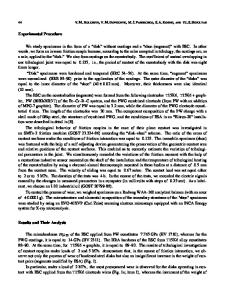Transfer behavior in low-amplitude oscillating wear of nanocrystalline copper under oil lubrication
- PDF / 1,053,476 Bytes
- 10 Pages / 585 x 783 pts Page_size
- 47 Downloads / 771 Views
Nanocrystalline (NC) Cu samples were synthesized by means of surface mechanical attrition treatment, from which a layer of NC structure was formed on a coarse-grained Cu plate. Low-amplitude oscillating wear/fretting behaviors of the NC Cu samples were investigated under oil lubrication in comparison with those of as-annealed coarse-grained Cu samples. It was found the NC Cu possesses a markedly enhanced wear resistance and a higher friction coefficient relative to the coarse-grained Cu. A continuous metal transfer layer is formed on the mating ball after fretting against the NC Cu, while no material transfer occurs for the as-annealed Cu. The effects of experimental parameters and the hardness of Cu samples on the formation of a transfer layer have been systematically investigated. The transfer layer is evidenced to play an important role in the enhanced wear resistance of the NC Cu, but it has a trivial effect on its high friction coefficient.
I. INTRODUCTION
Studies on the mechanical properties of nanocrystalline (NC) materials, especially tensile strength, ductility, and fatigue behavior, have been a focus of research. In recent decades, the friction and wear characteristics of nanostructured materials have also been paid more attention for their potential engineering applications. Most investigations with regard to this aspect have been performed on dual-phase alloys and composites, and systematic studies of wear in pure NC and ultrafine-grained metals have been less common. Jeong et al.1 reported much improvement in the abrasive wear resistance of electro-deposited NC nickel due to grain refinement. Schuh et al.2 found a reduction in grain size below 14 nm for NC nickel did not improve its scratch wear resistance, and Hanlon et al.3 examined the effect of grain size on friction evolution and damage accumulation in scratch tests. Sliding wear tests were also investigated on ultrafine-grained titanium,4 NC aluminum,5 copper,6–8 nickel, and cobalt.9 The results demonstrated that ultrafinegrained and NC metals exhibited enhanced wear resistance to a certain extent and decreased or unchanged friction coefficient as a result of grain refinement. While, to the best of our knowledge, only a few articles10,11 are available involving experimental phenomena in fretting,
a)
Address all correspondence to this author. e-mail: [email protected] DOI: 10.1557/JMR.2008.0034 150 J. Mater. Res., Vol. 23, No. 1, Jan 2008 http://journals.cambridge.org Downloaded: 16 Mar 2015
and no systematic investigation on fretting behavior of nanostructured metals has been reported. The transfer of material between contacting surfaces is usually encountered under fretting contacts, even under oil-lubricated conditions.12–14 It usually plays a critical role in the performance of many tribological systems, leading to either a reduction in friction coefficient and wear,13 or a rise in friction coefficient.14 Material transfer is a complex process and is determined by mechanical and chemical interactions at the rubbing surfaces. Though lots of
Data Loading...











